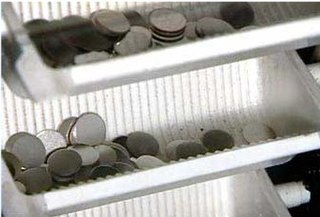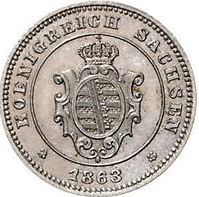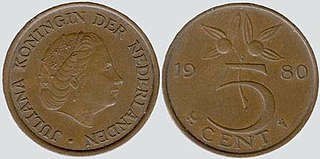
A planchet is a round metal disk that is ready to be struck as a coin. An older word for planchet is flan. They are also referred to as blanks.

The pfennig ; symbol pf or ₰) or penny is a former German coin or note, which was the official currency from the 9th century until the introduction of the euro in 2002. While a valuable coin during the Middle Ages, it lost its value through the years and was the minor coin of the Mark currencies in the German Reich, West Germany and East Germany, and the reunified Germany until the introduction of the euro. Pfennig was also the name of the subunit of the Danzig mark (1922–1923) and the Danzig gulden (1923–1939) in the Free City of Danzig.

Groschen is the name for various coins, especially a silver coin used in parts of Europe such as France, some of the Italian states, England, various states of the Holy Roman Empire, among others. The word is borrowed from the late Latin description of a tornose, a grossus denarius Turnosus, in English the "thick denarius of Tours". Groschen was frequently abbreviated in old documents to gl, whereby the second letter was not an l, but an abbreviation symbol; later it was written as Gr or g.

The Heller, abbreviation hlr, was a coin, originally valued at half a pfennig, that was issued in Switzerland and states of the Holy Roman Empire, surviving in some European countries until the 20th century.

The Neugroschen was a Saxon Scheidemünze coin minted from 1841 to 1873 which had the inscription Neugroschen. This groschen, made of billon, was equivalent to the Prussian groschen but, unlike the latter, was divided not into 12, but into 10 pfennigs.

The stuiver was a coin used in the Netherlands, worth 1⁄20 Dutch Guilders. It was also minted on the Lower Rhine region and the Dutch colonies. The word can still refer to the 5 euro cent coin, which has almost exactly the same diameter and colour despite being over twice the value of the older coin.

The history of Saxon coinage or Meissen-Saxon coinage comprises three major periods: the high medieval regional pfennig period, the late medieval pfennig period and the thaler period, which ended with the introduction of the mark in 1871/72. Rich silver deposits, which were discovered near Freiberg after the middle of the 12th century, helped Saxony to a leading position in German coinage.

A Schüsselpfennig, also Gehulchter Pfennig is so called due to the stamping technique which results in a concave, one-sided type of Pfennig coin. It was probably first minted in 1374 in the Palatinate. Small Schüsselpfennigs that had entered the Electorate of Saxony were referred to there as Näpfchenheller.
The Weckeler, also called a Weckelerpfennig, is a one-sided silver Palatine pfennig coin of the 14th and 15th century, which was also called the Wegkpfennig in the local dialect. It occurs both as a Schüsselpfennig and as a non-domed, planar coin. The pfennigs were given their contemporary name after their image, a lozenged coat of arms.

The Sachsenpfennig, sometimes called the Wendenpfennig or the Hochrandpfennig, was a well-known coin of the pfennig type minted in the eastern part of the Stem Duchy of Saxony during the 10th and 11th centuries. It had an upturned perimeter and, next to the Otto Adelheid Pfennig was the most common pfennig type of its time. Sachsenpfennigs are the oldest coins minted in Saxony. Its different names represent a lack of clarity within mediaeval numismatics about the coin.
The Meissen gulden, abbreviation Mfl., was a Rhenish Gold Gulden that was established in Saxony in 1490 at a value of 21 groschen and which, from 1542 to 1838 became a coin of account of the same value.

The Roter Seufzer, also called the Seufzer and Leipziger Seufzer, was the popular name of the inferior six-pfennig coin minted in huge quantities in 1701 and 1702 by the Prince-Elector of Saxony and King of Poland, Augustus the Strong (1694–1733). The name of these coins was due to the loss that the population suffered as a result of the coins which had a high copper content.
A Münzfuß is an historical term, used especially in the Holy Roman Empire, for an official minting or coinage standard that determines how many coins of a given type were to be struck from a specified unit of weight of precious metal. The Münzfuß, or Fuß ("foot") for short in numismatics, determined a coin's fineness, i.e. how much of a precious metal it would contain. Mintmaster Julian Eberhard Volckmar Claus defined the standard in his 1753 work, Kurzgefaßte Anleitung zum Probieren und Münzen, as follows: "The appropriate proportion of metals and the weight of the coin, measured according to their internal and external worth, or determined according to their quality, additives and fineness, number and weight, is called the Münzfuß."

The Guter Groschen, also Gutergroschen or Gutegroschen, abbreviation Ggr., is name of the groschen coin that was valued at 1⁄24 of a Reichsthaler from the end of the 16th century. It was called a "good groschen" to distinguish it from the lighter Mariengroschen, which was only valued at 1⁄36 Reichsthaler. The term Guter Groschen remained common until the middle of the 19th century.

The Bauerngroschen, also Burgroschen, was a groschen minted in the Free Imperial City of Goslar from 1477 until at least 1490 and continued to circulate until the 16th century. On the obverse it depicts a coat of arms with an imperial eagle beneath a helmet with a crown and on the reverse Saints, Simon and Jude. The two apostles were thought by the people to be farmers due to the poor quality stamping of the coins, hence the name, Bauerngroschen.

From the Late Middle Ages the albus was a common currency in parts of the Holy Roman Empire, especially in the Rhineland. The name albus is Latin and means "white". Because of its higher silver content, this lighter coin differed in colour from the other inferior coins. This resulted in the names denarius albus, Weißpfennig or Rhenish groschen.
The Andreas Hofer Kreuzer, also called the Hofer Kreuzer or Sandwirtszwanziger, was the name of the 20- and 1-kreuzer coins that were minted during the Tyrolean Rebellion in Hall in Tirol in 1809. The obverse depicts the Tyrolean Eagle and the inscription Gefürstete Grafschaft Tirol; the reverse shows the nominal value.

The Ewiger Pfennig or eternal penny was a coin of the regional pfennig period, which was minted until the late medieval groschen time. These coins are mostly of the Hohlpfennig or "hollow pfennig" type which, unlike bracteates, had to be exchanged regularly for a fee but were not subject to annual recall of coins in circulation, the Münzverruf.

The Zollpfennig was Pfennig coin with a special function, issued under Elector Charles Theodore (1742–1799) of the Palatinate in the years 1766, 1778 and minted in 1777 by the Landgraviate of Hesse-Darmstadt. Both were made of copper and were small or fractional coins. They served to finance the state and to equalize the value of payments between coins of different coinage standards.













